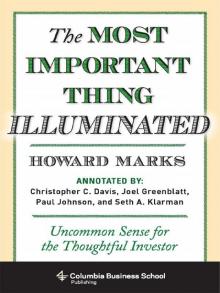- Home
- Howard Marks
The Most Important Thing Illuminated Page 5
The Most Important Thing Illuminated Read online
Page 5
The Most Important Thing Is … The Relationship Between Price and Value
Investment success doesn’t come from “buying good things,” but rather from “buying things well.”
Let’s say you’ve become convinced of the efficacy of value investing and you’re able to come up with an estimate of intrinsic value for a stock or other asset. Let’s even say your estimate is right. You’re not done. In order to know what action to take, you have to look at the asset’s price relative to its value. Establishing a healthy relationship between fundamentals—value—and price is at the core of successful investing.
For a value investor, price has to be the starting point. It has been demonstrated time and time again that no asset is so good that it can’t become a bad investment if bought at too high a price. And there are few assets so bad that they can’t be a good investment when bought cheap enough.
CHRISTOPHER DAVIS: However, investors should be wary of the risk of obsolescence, which can turn a cheap stock into a value trap.
When people say flatly, “we only buy A” or “A is a superior asset class,” that sounds a lot like “we’d buy A at any price … and we’d buy it before B, C or D at any price.” That just has to be a mistake. No asset class or investment has the birthright of a high return. It’s only attractive if it’s priced right.
Hopefully, if I offered to sell you my car, you’d ask the price before saying yes or no. Deciding on an investment without carefully considering the fairness of its price is just as silly. But when people decide without disciplined consideration of valuation that they want to own something, as they did with tech stocks in the late 1990s—or that they simply won’t own something, as they did with junk bonds in the 1970s and early 1980s—that’s just what they’re doing.
Bottom line: there’s no such thing as a good or bad idea regardless of price!
“THE MOST IMPORTANT THING,” JULY 1, 2003
JOEL GREENBLATT: Individual investors need to think of this “most important” point with every investment decision. No matter how good an investment sounds, if price has not yet been considered, you can’t know if it is a good investment.
It’s a fundamental premise of the efficient market hypothesis—and it makes perfect sense—that if you buy something for its fair value, you can expect a return that is fair given the risk. But active investors aren’t in it for fair risk-adjusted returns; they want superior returns. (If you’ll be satisfied with fair returns, why not invest passively in an index fund and save a lot of trouble?) So buying something at its intrinsic value is no great shakes. And paying more than something’s worth is clearly a mistake; it takes a lot of hard work or a lot of luck to turn something bought at a too-high price into a successful investment.
Remember the Nifty Fifty investing I described in the last chapter? At their highs, many of those stalwart companies sported price/earnings ratios (the ratio of the stock’s price to the earnings behind each share) between 80 and 90. (For comparison, the postwar average price/earnings ratio for stocks in general has been in the midteens.) None of their partisans appeared to be worried about those elevated valuations.
Then, in just a few years, everything changed. In the early 1970s, the stock market cooled off, exogenous factors like the oil embargo and rising inflation clouded the picture and the Nifty Fifty stocks collapsed. Within a few years, those price/earnings ratios of 80 or 90 had fallen to 8 or 9, meaning investors in America’s best companies had lost 90 percent of their money. People may have bought into great companies, but they paid the wrong price.
At Oaktree we say, “Well bought is half sold.” By this we mean we don’t spend a lot of time thinking about what price we’re going to be able to sell a holding for, or when, or to whom, or through what mechanism. If you’ve bought it cheap, eventually those questions will answer themselves.
JOEL GREENBLATT: Many value investors are not good at knowing when to sell (and many sell way too early). However, knowing when to buy cures many of the mistakes resulting from selling too early.
If your estimate of intrinsic value is correct, over time an asset’s price should converge with its value.
JOEL GREENBLATT: Keeping this statement in mind, that the market eventually gets it right, is one of the most important things to remember when the market acts emotionally over the short term.
What are the companies worth? Eventually, this is what it comes down to. It’s not enough to buy a share in a good idea, or even a good business. You must buy it at a reasonable (or, hopefully, a bargain) price.
“BUBBLE.COM,” JANUARY 3, 2000
All of this begs the question, what goes into the price? What should a prospective buyer be looking at to be sure the price is right? Underlying fundamental value, of course, but most of the time a security’s price will be affected at least as much—and its short-term fluctuations determined primarily—by two other factors: psychology and technicals.
Most investors—and certainly most nonprofessionals—know little about technicals. These are nonfundamental factors—that is, things unrelated to value—that affect the supply and demand for securities. Two examples: the forced selling that takes place when market crashes cause levered investors to receive margin calls and be sold out, and the inflows of cash to mutual funds that require portfolio managers to buy. In both cases, people are forced to enter into securities transactions without much regard for price.
Believe me, there’s nothing better than buying from someone who has to sell regardless of price during a crash. Many of the best buys we’ve ever made occurred for that reason. A couple of observations are in order, however:
• You can’t make a career out of buying from forced sellers and selling to forced buyers; they’re not around all the time, just on rare occasions at the extremes of crises and bubbles.
• Since buying from a forced seller is the best thing in our world, being a forced seller is the worst. That means it’s essential to arrange your affairs so you’ll be able to hold on—and not sell—at the worst of times. This requires both long-term capital and strong psychological resources.
JOEL GREENBLATT: For an individual investor this means that if you have invested too much in the market or in a particular investment and you can’t take the pain during periods of downside volatility, you can create a situation where you are the forced seller that Marks talks about here.
And that brings me to the second factor that exerts such a powerful influence on price: psychology. It’s impossible to overstate how important this is. In fact, it’s so vital that several later chapters are devoted to discussing investor psychology and how to deal with its manifestations.
Whereas the key to ascertaining value is skilled financial analysis, the key to understanding the price/value relationship—and the outlook for it—lies largely in insight into other investors’ minds. Investor psychology can cause a security to be priced just about anywhere in the short run, regardless of its fundamentals.
JOEL GREENBLATT: Once again, as Buffett would say, the best investment class would teach how to estimate value and then how to think about market prices. Merely understanding that prices can deviate wildly from value over the short run is key. Understanding psychology so that you can take advantage of these deviations when they appear is the hard part.
The discipline that is most important is not accounting or economics, but psychology.
The key is who likes the investment now and who doesn’t. Future price changes will be determined by whether it comes to be liked by more people or fewer people in the future.
Investing is a popularity contest, and the most dangerous thing is to buy something at the peak of its popularity. At that point, all favorable facts and opinions are already factored into its price, and no new buyers are left to emerge.
HOWARD MARKS: The second key theme isn’t “the most important thing,” but “the riskiest things.” The book, preoccupied with risk as it is, describes a large number of things that make investing perilous. Pulling them togeth
er through these annotations should help you recognize them and thus avoid them. The biggest losers—be they Nifty-Fifty stocks in 1969, Internet stocks in 1999, or mortgage vehicles in 2006—had something in common: no one could find a flaw. There are lots of ways to describe this condition: “priced for perfection,” “on the pedestal of popularity,” and “nothing can go wrong.” Nothing’s perfect, however, and everything eventually turns out to have flaws. When you pay for perfection, you don’t get what you expected, and the high price you pay exposes you to risk of loss when reality comes to light. This is truly one of the riskiest things.
The safest and most potentially profitable thing is to buy something when no one likes it. Given time, its popularity, and thus its price, can only go one way: up.
“RANDOM THOUGHTS ON THE IDENTIFICATION OF INVESTMENT OPPORTUNITIES,” JANUARY 24, 1994
Clearly, this is yet another area that is (a) of critical importance and (b) extremely hard to master.
PAUL JOHNSON: This comment is particularly important for students, as they tend to have limited experience.
First, psychology is elusive. And second, the psychological factors that weigh on other investors’ minds and influence their actions will weigh on yours as well. As you will read in later chapters, these forces tend to cause people to do the opposite of what a superior investor must do. For self-protection, then, you must invest the time and energy to understand market psychology.
HOWARD MARKS: “The human side of investing” is the critical side. It’s certainly an area in which superior investors must excel, since financial analysis won’t guarantee superior performance if your reactions to developments are skewed by psychology just like those of others. Thus my third key theme relates to control over emotion and ego. Accomplishing this is quite difficult, since everything in the investing environment conspires to make investors do the wrong thing at the wrong time. We’re all only human, so the challenge is to perform better than other investors even though we start with the same wiring.
It’s essential to understand that fundamental value will be only one of the factors determining a security’s price on the day you buy it. Try to have psychology and technicals on your side as well.
The polar opposite of conscientious value investing is mindlessly chasing bubbles, in which the relationship between price and value is totally ignored.
All bubbles start with some nugget of truth:
• Tulips are beautiful and rare (in seventeenth-century Holland).
• The Internet is going to change the world.
• Real estate can keep up with inflation, and you can always live in a house.
A few clever investors figure out (or perhaps even foresee) these truths, invest in the asset, and begin to show profits. Then others catch on to the idea—or just notice that people are making money—and they buy as well, lifting the asset’s price. But as the price rises further and investors become more inflamed by the possibility of easy money, they think less and less about whether the price is fair. It’s an extreme rendition of the phenomenon I described earlier: people should like something less when its price rises, but in investing they often like it more.
JOEL GREENBLATT: This is uncanny but often true. People are attracted to those investments that have performed well lately. They are also attracted to professional managers who have performed well lately, though there is usually not much correlation with that manager’s future performance.
In 2004–2006, for example, people could conjure up only good things about houses and condos: the desirability of participating in the American dream of home ownership; the ability to benefit from inflation; the fact that mortgage loans were cheap and payments would be tax deductible; and ultimately the accepted wisdom that “home prices only go up.” We all know what happened to that little nugget of wisdom.
And what of that other infamous “can’t lose” idea? In the tech bubble, buyers didn’t worry about whether a stock was priced too high because they were sure someone else would be willing to pay them more for it. Unfortunately, the greater fool theory works only until it doesn’t. Valuation eventually comes into play, and those who are holding the bag when it does have to face the music.
• The positives behind stocks can be genuine and still produce losses if you overpay for them.
• Those positives—and the massive profits that seemingly everyone else is enjoying—can eventually cause those who have resisted participating to capitulate and buy.
• A “top” in a stock, group or market occurs when the last holdout who will become a buyer does so. The timing is often unrelated to fundamental developments.
• “Prices are too high” is far from synonymous with “the next move will be downward.” Things can be overpriced and stay that way for a long time … or become far more so.
• Eventually, though, valuation has to matter.
JOEL GREENBLATT: Read that final bullet again!
PAUL JOHNSON: These points are so very true, although challenging to master while engulfed in the endorphin rush of a mania or bubble.
“BUBBLE.COM,” JANUARY 3, 2000
The problem is that in bubbles, “attractive” morphs into “attractive at any price.” People often say, “It’s not cheap, but I think it’ll keep going up because of excess liquidity” (or any number of other reasons). In other words, they say, “It’s fully priced, but I think it’ll become more so.” Buying or holding on that basis is extremely chancy, but that’s what makes bubbles.
In bubbles, infatuation with market momentum takes over from any notion of value and fair price, and greed (plus the pain of standing by as others make seemingly easy money) neutralizes any prudence that might otherwise hold sway.
To sum up, I believe that an investment approach based on solid value is the most dependable. In contrast, counting on others to give you a profit regardless of value—relying on a bubble—is probably the least.
Consider the possible routes to investment profit:
• Benefiting from a rise in the asset’s intrinsic value. The problem is that increases in value are hard to predict accurately. Further, the conventional view of the potential for increase is usually baked into the asset’s price, meaning that unless your view is different from the consensus and superior, it’s likely you’re already paying for the potential improvement.
In certain areas of investing—most notably private equity (the buying of companies) and real estate—“control investors” can strive to create increases in value through active management of the asset. This is worth doing, but it’s time-consuming and uncertain and requires considerable expertise. And it can be hard to bring about improvement, for example, in an already good company.
• Applying leverage. Here the problem is that using leverage—buying with borrowed money—doesn’t make anything a better investment or increase the probability of gains. It merely magnifies whatever gains or losses may materialize. And it introduces the risk of ruin if a portfolio fails to satisfy a contractual value test and lenders can demand their money back at a time when prices and illiquidity are depressed. Over the years leverage has been associated with high returns, but also with the most spectacular meltdowns and crashes.
PAUL JOHNSON: This is one of the most important comments in chapter 4. This is a lesson that all young investors fail to learn at their own peril.
• Selling for more than your asset’s worth. Everyone hopes a buyer will come along who’s willing to overpay for what they have for sale. But certainly the hoped-for arrival of this sucker can’t be counted on. Unlike having an underpriced asset move to its fair value, expecting appreciation on the part of a fairly priced or overpriced asset requires irrationality on the part of buyers that absolutely cannot be considered dependable.
• Buying something for less than its value. In my opinion, this is what it’s all about—the most dependable way to make money. Buying at a discount from intrinsic value and having the asset’s price move toward its value doesn’t requi
re serendipity; it just requires that market participants wake up to reality. When the market’s functioning properly, value exerts a magnetic pull on price.
JOEL GREENBLATT: Eventually, the market does operate and get it “right.” Read Marks’s statement again; it is an incredibly useful image.
PAUL JOHNSON: Here, Marks articulates the simple beauty behind value investing. Buying at the right price is the hard part of the exercise. Once done correctly, time and other market participants take care of the rest.
Of all the possible routes to investment profit, buying cheap is clearly the most reliable. Even that, however, isn’t sure to work. You can be wrong about the current value. Or events can come along that reduce value. Or deterioration in attitudes or markets can make something sell even further below its value. Or the convergence of price and intrinsic value can take more time than you have; as John Maynard Keynes pointed out, “The market can remain irrational longer than you can remain solvent.”
HOWARD MARKS: Fear of looking wrong: It comes as quite a shock to many new investors how long it can take for even correct judgments to work out. One of the most important roles of your strong view of intrinsic value is as a foundation for conviction: to help you hang in until the market comes to agree with you and prices the asset where it should.
Trying to buy below value isn’t infallible, but it’s the best chance we have.

 Mr Nice
Mr Nice The Howard Marks Book of Dope Stories
The Howard Marks Book of Dope Stories Senor Nice: Straight Life From Wales to South America
Senor Nice: Straight Life From Wales to South America The Score
The Score Sympathy for the Devil
Sympathy for the Devil The Most Important Thing Illuminated
The Most Important Thing Illuminated Senor Nice
Senor Nice Howard Marks' Book of Dope Stories
Howard Marks' Book of Dope Stories